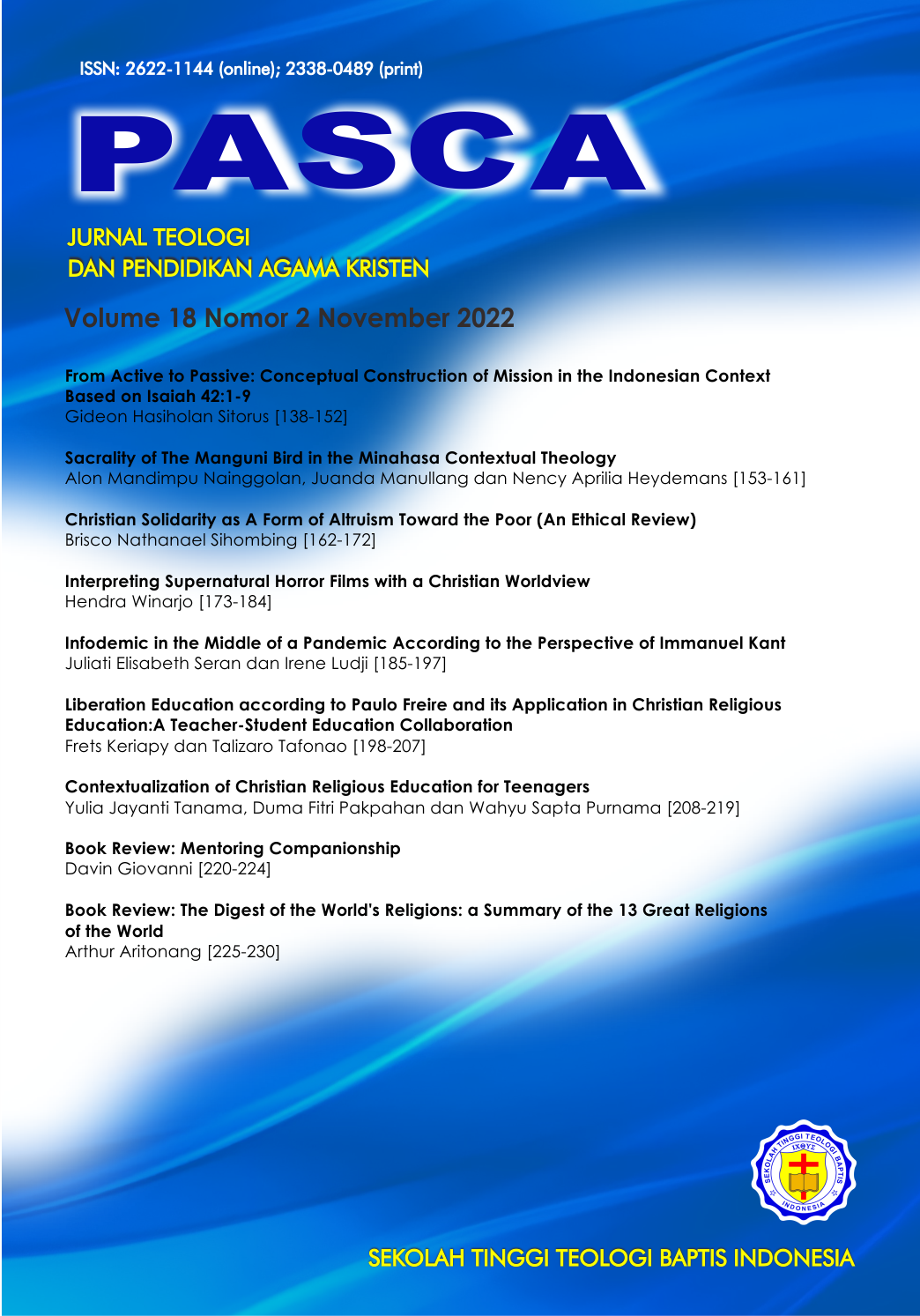Interpreting Supernatural Horror Films with a Christian Worldview
DOI:
https://doi.org/10.46494/psc.v18i2.216Keywords:
supernatural, horror films, theology, film, Christian worldviewAbstract
This article offers a theological framework for interpreting supernatural horror films with a Christian worldview based on narratives of creation, fall, redemption, and glorification. By doing library research, this article describes supernatural horror films. It analyzes a Christian worldview of the relationship between God, humans, and demons, as well as the pocong film through that worldview. Thus, supernatural horror films can show values and hopes that support Christian narratives. On the other hand, it can also reject Christian narratives because supernatural horror films as religious and cultural products have values and ideas that are not always in line with God's revelation, which is rooted in God's revelation that views demons and so on as finite creation, has been defeated through the work of Christ, and the promise of demons final defeat and so on in the new heaven and earth. Ultimately, this article interprets the pocong film narrative as a case study. As a result, pocong films have a discrepancy with Christian narratives, such as the dead being able to "come back to life." However, they also have similarities, such as emphasizing the existence of supernatural beings who play the antagonist role.
References
Anderson, Tawa J., W. Michael Clark, and David K. Naugle. Naugle, An Introduction to Christian Worldview: Pursuing God’s Perspective in a Pluralistic World. Downers Grove: InterVarsity, 2017.
Aulén, Gustaf. Christus Victor: An Historical Study of the Three Main Types of the Idea of the Atonement. Edited by A.G. Hebert. Eugene: Wipf & Stock, 2003.
Bartholomew, Craig G., and Michael W. Goheen. The Drama of Scripture: Finding Our Place in the Biblical Story. 2nd ed. Grand Rapids: Baker, 2014.
Bavinck, Herman. Reformed Dogmatics: Abridged in One Volume. Edited by John Bolt. Grand Rapids: Baker, 2011.
Beavis, Marry Ann. “Angels Carrying Savage Weapons:’ Uses of the Bible in Contemporary Horror Films.” Journal of Religion & Film 7, no. 2 (2003). https://digitalcommons.unomaha.edu/jrf/vol7/iss2/2.
Beeke, Joel R., and Paul M. Smalley. Reformed Systematic Theology, Vol. 1, Revelation and God. Wheaton: Crossway, 2019.
Burk, Denny. Four Views on Hell. Edited by Preston Sprinkle. Grand Rapids: Zondervan, 2016.
Carroll, Noël. The Philosophy of Horror: Or, Paradoxes of the Heart. London: Routledge, 1990.
Cloete, Anita L. “Film as Medium for Meaning Making: A Practical Theological Reflection.” HTS Teologiese Studies / Theological Studies, 2017. https://doi.org/10.4102/hts.v73i4.4753.
Cole, Graham A. Against the Darkness: The Doctrine of Angels, Satan, and Demons. Wheaton: Crossway, 2019.
Debby, Yohana, Theresia Intan Putri Hartiana, and Nanang Krisdinanto. “Desakralisasi Film Horor Indonesia Dalam Kajian Reception Analysis.” ProTVF, 2020. https://doi.org/10.24198/ptvf.v4i1.24171.
Frame, John M. Systematic Theology: An Introduction to Christian Belief. Phillipsburg: P&R, 2013.
Fraser, Peter. A Christian Response to Horror Cinema Ten Films in Theological Perspective. Jefferson: McFarland, 2015.
Genta, Bonaventura D., Mada Zidan, and Hari Kurniawan. Pocong Gundul. Jakarta: Gagas Media, 2018.
Grudem, Wayne. Systematic Theology: An Introduction to Biblical Doctrine. Grand Rapids: Zondervan, 2020.
Handoko, Yakub Tri. “Apakah Boleh Menonton Film Horor?” Reformed Exodus Community, 2022. https://rec.or.id/apakah-boleh-menonton-film-horor.
Juld, Rahel Jum, and I Ketut Enoh. “Okultisme Dalam Pelayanan Pastoral.” Jurnal Jaffray, 2013. https://doi.org/10.25278/jj71.v11i2.83.
Lukito, Daniel L. Pudarnya Konsep Dosa Dalam Dunia Kekinian: Doktrin Tentang Dosa. Malang: Literatur SAAT, 2019.
Mamahit, Ferry Yefta. “Christus Victor Dan Kemenangan Orang Kristen Terhadap Kuasa Kegelapan.” Veritas: Jurnal Teologi Dan Pelayanan, 2004. https://doi.org/10.36421/veritas.v5i1.125.
Martin, G. Neil. “(Why) Do You like Scary Movies? A Review of the Empirical Research on Psychological Responses to Horror Films.” Frontiers in Psychology, 2019. https://doi.org/10.3389/fpsyg.2019.02298.
Moses, Robert. “The Satan in Light of the Creation Theology of Job.” Horizons in Biblical Theology, 2012. https://doi.org/10.1163/187122012X602558.
Noer, Achmad Ridwan. “We Choose What to Fear in Indonesian Horror Cinema.” Communicare?: Journal of Communication Studies, 2021. https://doi.org/10.37535/101008120215.
Pahlevi, Reza. “KKN Desa Penari, Film Horor Terlaris Di Indonesia.” Databoks, 2022. https://databoks.katadata.co.id/datapublish/2022/05/17/kkn-desa-penari-film-horor-terlaris-di-indonesia.
Plantinga, Alvin. God, Freedom, and Evil. Grand Rapids: Eerdmans, 1974.
Prohászková, Mgr Viktória. “The Genre of Horror.” American International Journal of Contemporary Research, 2012.
Redaksi. “67 Persen Anak Muda Indonesia Menonton Film Nasional Dan Hanya 55 Persen Menonton Film Asing.” Saiful Mujani Research and Consulting, 2022. https://saifulmujani.com/67-persen-anak-muda-indonesia-menonton-film-nasional-dan-hanya-55-persen-menonton-film-asing/.
Salurante, Tony. “Wawasan Dunia Kristen Sebagai Penunjuk Arah Gereja Modern Bermisi.” WawasanDunia Kristen Sebagai Penunjuk Arah Gereja Modern Bermisi, 2021.
Samuel, Lucky. “Tinjauan Kritis Terhadap Film-Film Horor Indonesia Dari Perspektif Demonologi Kristen.” Veritas: Jurnal Teologi Dan Pelayanan, 2010. https://doi.org/10.36421/veritas.v11i1.224.
Saputra, Aji Dwi, and Edo Galasro Limbong. “Visualisasi Karakter Pocong, Kuntilanak, Dan Tuyul Pada Film Animasi Keluarga Hantu Indonesia.” Jurnal Desain, 2019. https://doi.org/10.30998/jd.v7i01.5468.
Sire, James W. The Universe Next Door: A Basic Worldview Catalog. 6th ed. Downers Grove: InterVarsity, 2020.
Stevanus, Kalis. “Menyoal Konsep Kesembuhan Tubuh: Suatu Kajian Teologis.” PASCA: Jurnal Teologi Dan Pendidikan Agama Kristen, 2021. https://doi.org/10.46494/psc.v17i2.154.
Stone, Bryan. “The Sanctification of Fear: Images of the Religious in Horror Films.” Journal of Religion & Film 5, no. 2 (2001). https://digitalcommons.unomaha.edu/jrf/vol5/iss2/7.
Strinati, Dominic. An Introduction to Studying Popular Culture. London: Routledge, 2000.
Supriadi, Made Nopen. “Pendekatan Sejarah Penebusan Dalam Penafsiran Alkitab.” PASCA: Jurnal Teologi Dan Pendidikan Agama Kristen, 2021. https://doi.org/10.46494/psc.v17i1.136.
Sutanto, Nathaniel. “Herman Bavinck on the Image of God and Original Sin.” International Journal of Systematic Theology, 2016. https://doi.org/10.1111/ijst.12138.
Vanhoozer, Kevin J. Redemption Accomplished: Atonement. Edited by Michael Allen and Scott R. Swain. Oxford: Oxford University Press, 2020.
Wright, Arthur M. “Disarming the Rulers and Authorities: Reading Colossians in Its Roman Imperial Context.” Review & Expositor, 2019. https://doi.org/10.1177/0034637319879033.
Yang, Haiyang, and Kuangjie Zhang. “The Psychology Behind Why We Love (or Hate) Horror.” Harvard Business Review, 2021. https://hbr.org/2021/10/the-psychology-behind-why-we-love-or-hate-horror.
Zaluchu, Sonny Eli. “Strategi Penelitian Kualitatif Dan Kuantitatif Di Dalam Penelitian Agama.” Evangelikal: Jurnal Teologi Injili Dan Pembinaan Warga Jemaat 4, no. 1 (2020): 28. https://doi.org/10.46445/ejti.v4i1.167.
Published
How to Cite
Issue
Section
Copyright (c) 2022 Hendra Winarjo
PASCA: Jurnal Teologi dan Pendidikan Agama Kristen is licensed under a Creative Commons Attribution-ShareAlike 4.0 International License.



























